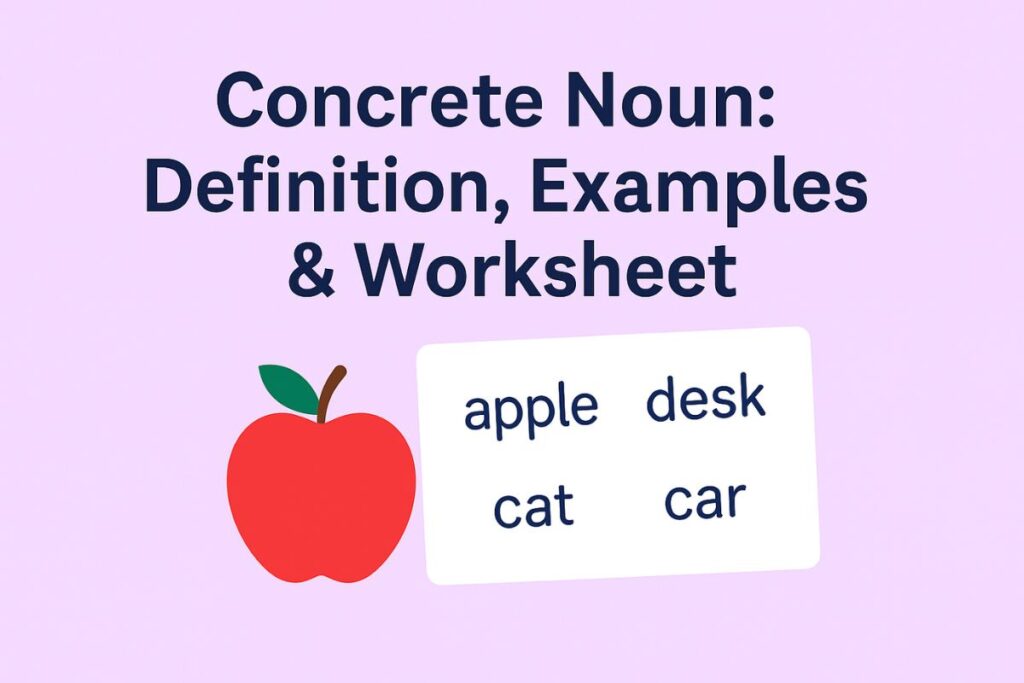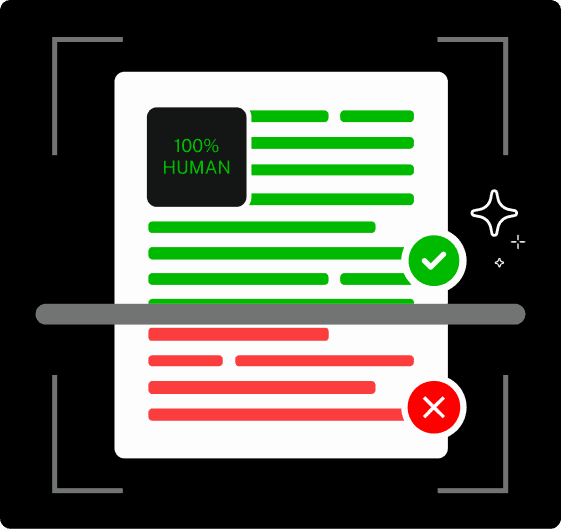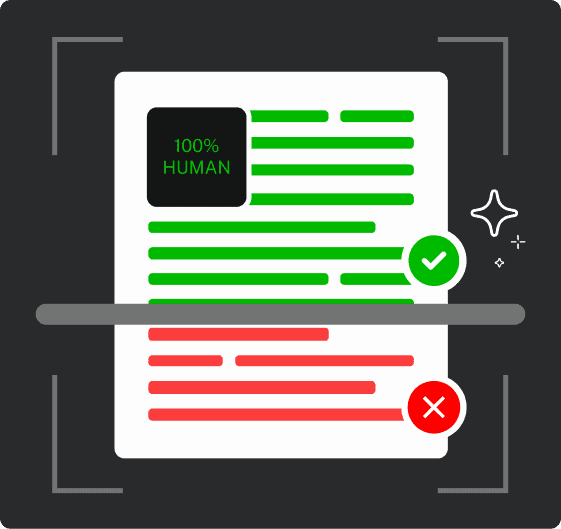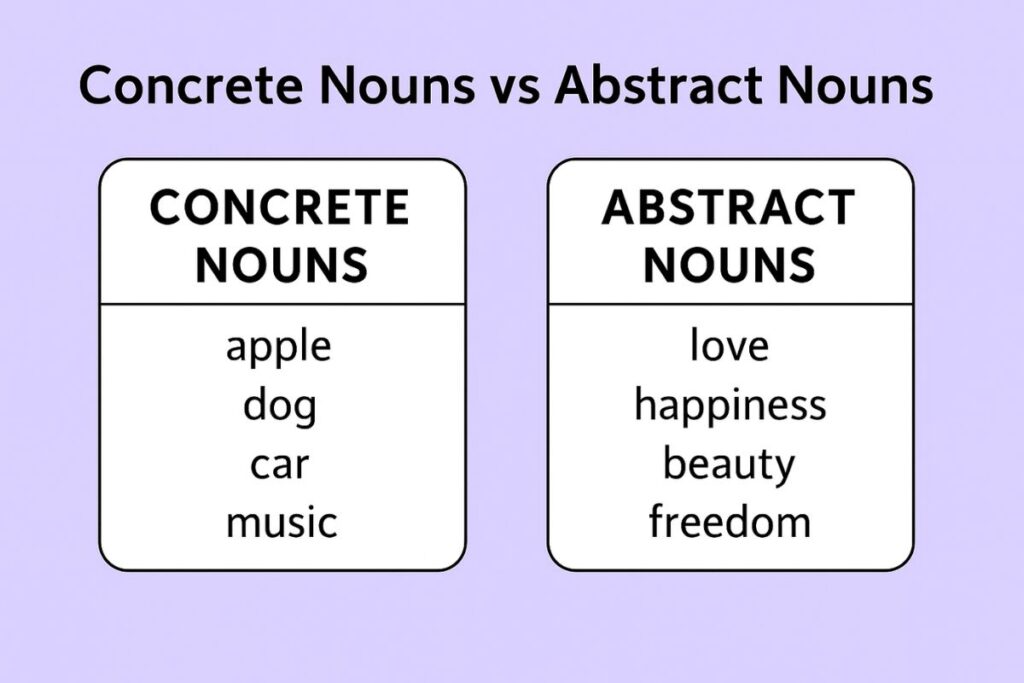English grammar categorizes nouns in every way imaginable, countable vs uncountable, common vs proper, singular vs plural, and concrete vs abstract.
Concrete nouns are described based on physical presence.
If you can actually sense the thing you’re talking about by seeing it , hearing it, smelling it, or touching it, it qualifies as concrete.
However, if it just floats around in your brain like a concept cloud, then it’s an abstract noun.
In this article, I’ll talk about exactly what is a concrete noun, how to spot one using the five senses test, and its different types you’ll run into.
Key Takeaways
- Concrete nouns name things you can experience through the five senses, i.e., you can see, hear, smell, touch, or taste them.
- They anchor language in the real world, especially for children and language learners who learn through physical interaction.
- Writers use concrete nouns alongside abstract nouns to create layered, emotionally rich scenes.
- There are different types of concrete nouns, e.g., countable vs uncountable, common vs proper, and collective concrete nouns.
Definition of a Concrete Noun

A concrete noun is the name of something you can experience directly through your five senses.
This category of nouns is usually one of the first people grasp when learning a language, because it’s so intuitive.
When you point to a dog and say “dog,” it’s simple to understand, the dog is right there, wagging its tail. It is real and observable.


Never Worry About AI Detecting Your Texts Again. Undetectable AI Can Help You:
- Make your AI assisted writing appear human-like.
- Bypass all major AI detection tools with just one click.
- Use AI safely and confidently in school and work.
Compare it to an abstract noun like hope. You know it exists, but you can’t pour it into a cup or describe its scent, you can’t see it or hear it directly either.
It’s real, sure, but not in a way your body can sense.
What Makes a Noun “Concrete”?
A noun becomes “concrete” because of how we interact with it physically.
According to concrete noun definition, if the thing it names can be perceived, even just slightly, through a sense, it is concrete.
For example, take the word cake. You can see it sitting on a plate, smell it fresh out of the oven, taste it with frosting, and probably touch it with your fingers when you sneak a bite.
Now think about knowledge. It’s something we work toward, even spend years acquiring, but you can’t really see it or touch it.
You can see someone studying, but you can’t watch knowledge itself walk into the room. So, it’s an abstract noun, not a concrete one.
Also, if a toddler can recognize a noun, it’s probably concrete.
Kids start language with concrete nouns because they learn by interacting with the world around them.
Words like ball, dog, milk, and bed are early vocabulary staples because the child can physically experience each of those things.
The Five Senses Test
Now that you know what’s a concrete noun, here’s a quick way to tell if it’s concrete or not; run it through the five senses.
Ask yourself:
- Can I see it?
- Can I hear it?
- Can I touch it?
- Can I taste it?
- Can I smell it?
If the answer is “yes” to even one of those, you’re dealing with a concrete noun.
Let’s try a few examples now:
- Popcorn? Yes, you can see it, hear it popping, smell it, touch it, and definitely taste it. It’s a concrete noun.
- Fear? You can feel it emotionally, but there’s nothing to see or touch, so it’s abstract.
- Fog? You can see it and maybe even feel it on your skin, which makes it concrete.
- Democracy? You can talk about it, vote on it, argue over it, but you can’t sense it in any way, so it is not concrete.
If you’re still stuck, you can simply use Ask AI to sort it out for you. Just type in the word you’re unsure about, and Ask AI will give you a clear verdict about whether it’s concrete or abstract.
Examples of Concrete Nouns
Let’s look at different concrete noun examples now.
- People: teacher, firefighter, child
People are concrete because we see them, talk to them, and probably get annoyed by them on a regular basis.
When you say teacher, you refer to an actual person who stands in front of a classroom with a marker writing on the board.
The same goes for firefighters. You can see one in uniform and hear their siren blaring while responding to emergencies.
A child is a living, breathing person you can see playing, hear laughing (or crying), and pick up or hug.
- Animals: dog, elephant, butterfly
Animals are another easy group of concrete nouns.
A dog is something you can see running in a yard, hear barking at the door, and pet with your hand.
An elephant, although much larger, is just as physical, you can watch it move, hear its trumpet, and observe its wrinkled skin.
Even a butterfly, light as it may be, is still visible. You can watch its wings flutter, and if you’re gentle enough, you might even feel it land on your hand.
- Places: school, park, restaurant
Many places count as concrete too because it is possible to experience the physical locations with your senses.
A school, a park, or a restaurant, for example, are all locations you can interact with directly.
They’re places that exist in real space, that engage your senses, and that you can physically point to on a map or with your finger in real life.
- Things: book, phone, pizza
Objects and items are some of the most obvious examples of concrete nouns.
You can see a book, hold one in your hands, flip through, underline, or smell the vintage scent if it’s an old one.
A phone makes sounds, lights up, vibrates, and lets you tap, swipe, and talk, every one of those interactions involves the senses.
A pizza is the most compelling example of all. You can see the cheese bubbling, smell the sauce and spices, feel the warmth, hear the crunch of the crust, and, of course, taste it.
- Proper Nouns That Are Concrete
Just because a noun is proper doesn’t mean it stops being concrete.
A proper noun is just the specific, capitalized name of a person, place, or thing. If that name refers to something you can experience with your senses, then it’s still a concrete noun.
Take Lahore city, for example. It’s not just a name on a map.
You can walk through its streets, hear the chaos of rickshaws, smell kebabs sizzling at roadside stalls, and see the sun hitting Badshahi Mosque just right.
Beyoncé, another proper noun, is a living, breathing human being.
You can hear her sing, watch her perform, and if you ever meet her (unlikely, but hey, dream big), you could technically high-five her.
Let’s throw in Google Headquarters. Again, it’s a real place with buildings, desks, and people.
Concrete Nouns vs Abstract Nouns
We’ve talked in detail about how concrete nouns are words for things you can detect with at least one of your five senses.
On the other hand, an abstract noun refers to something that has no physical form. It represents a concept, feeling, or quality.

- Key Differences Explained
The main difference between concrete and abstract nouns comes down to whether or not you can physically interact with it.
All concrete nouns we’ve talked about so far are things that take up space in the real world, and can be pointed to.
Abstract nouns, however, mainly exist in our heads. You can’t smell love, or hold a piece of honesty in your hand. These are emotions or qualities that live in the mind, not in the physical world.
Also, abstract nouns aren’t tied to any specific time or place.
You can talk about happiness without needing to say when or where it happened. It’s not something that can be located.
- When Both Can Exist Together
Human experience is layered. We perceive the world physically, but interpret it emotionally and intellectually. Therefore, sentences used in everyday language often blend both concrete and abstract nouns.
Here’s an example: He clenched the letter in his hands with regret.
In this sentence, a letter counts a concrete noun because it is a physical object with ink on paper.
Regret, however, is an abstract concept with no physical presence that can be seen, heard, touched. With both nouns used in the same sentence, we combine a real-world object with an internal experience.
Writers, especially in fiction or persuasive writing, use both types of nouns in the same sentence deliberately. It grounds the reader in a real scene while also delivering a layer of emotion.
- Sensory vs Conceptual Clarity
The brain processes an idea being named either through the senses or through conceptual reasoning.
Concrete nouns are tied to sensory clarity. They light up the sensory and motor areas of the brain.
Seeing the word hammer, for example, can actually trigger neural activity in regions responsible for gripping and hand movement, even if you’re not physically holding anything.
The brain treats them as real, physical items that exist in space and can be interacted with.
Abstract nouns, in contrast, require conceptual clarity. The brain can not process them through sensory input.
Instead, it recruits higher-level language areas and makes sense of the concept from personal experience, memory, emotion, and cultural understanding.
Types of Concrete Nouns

Concrete nouns are of many different types. Let’s explore them.
Countable vs Uncountable
Countable concrete nouns are physical things that exist as separate, individual units. They can be pluralized and paired with numbers.
For instance:
- Chair, car, banana
- One chair, five cars, a dozen bananas
Uncountable concrete nouns are materials that aren’t naturally divided into distinct parts. Milk, sugar, sand, and wood are examples of such nouns.
You can’t say “three sugars” unless you’re referring to containers, like “three jars of sugar.”
Common vs Proper
A concrete noun can be common or proper.
A common concrete noun is used for any member of a category.
Words like tree, dog, restaurant, or phone fall into this group as they all describe physical things but don’t name one in particular.
Such nouns are written in lowercase unless they start a sentence.
Proper concrete nouns name a specific person, place, or thing. Some of their examples include:
- Charlie (a specific person’s name)
- Starbucks (a restaurant)
- iPhone 16 (a specific brand and model)
Collective Concrete Nouns
A collective noun is a group of people, animals, or objects treated as a single unit.
When these groups are made up of physical, tangible things, the noun is considered concrete.
Even though the group is one “thing” grammatically, you could still point at it in the real world.
For example:
- A flock of birds flying across the sky
- A stack of books on the desk
Since the human brain processes sensory detail very fast, concrete nouns give writing texture. They make your narration immersive and are easily remembered by the reader.
You can use Undetectable AI’s AI Humanizer to swap out lifeless phrases for vivid, concrete ones that spark sensory connections.
Common Mistakes with Concrete Nouns
Many students still trip over concrete nouns. Here are some common mistakes that come up:
- Mistaking abstract words for concrete ones when students go by meaning instead of sensory experience.
- Reaching for vague, placeholder nouns like “stuff” or “thing” instead of specific concrete nouns that add detail to the sentence
- Treating all proper nouns as abstract, while many proper nouns refer to actual places or objects
- Students often also forget the difference between countable and uncountable nouns
- The same word can be concrete or abstract depending on how it’s used in a sentence. Some concrete nouns may be used metaphorically, which throws students off-guard.
Make every word count—refine AI-written text quickly in the widget below.
Final Thoughts
You’ll see concrete nouns everywhere in good storytelling, persuasive writing, academic projects, and everyday communication.
Writers who lean on concrete nouns also tend to write with more clarity and impact.
Undetectable AI has the perfect suite of tools for learning grammar.
Use Ask AI to get help on any school project where you’re confused about word choice and whether a word is concrete or abstract.
The AI Humanizer rewrites your content to sound more natural. It strips out robotic phrasing and swaps in words that carry real sensory weight.
So if your work could use more life, give Undetectable AI a try!
